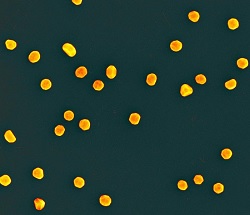 |
| Gold nanoparticles at 250,000 times magnification created by the National Institute of Standards and Technology and the National Cancer Institute--Courtesy of NIST |
Gold nanoparticles, because of several inherent characteristics, make excellent drug delivery vehicles, and scientists around the world are now studying the way the tiny particles penetrate cell membranes based on their positive or negative surface charges.
Researchers at the Institut Laue-Langevin in France, the University of Chicago and the Australian Science and Technology Organization have studied the way differently charged gold particles affect cell membranes. They found that positively charged particles penetrate--and at high concentrations, destroy--the membrane easily, while those that are negatively charged help keep the membrane intact. The result demonstrates the particles' effectiveness as delivery vehicles as well as safety concerns associated with their membrane-destroying capabilities.
To study this in the lab, the researchers built synthetic membranes that mimic natural lipid bilayers and blasted these structures with neutrons to characterize their stability after exposure to gold nanoparticles, according to a report in Physics World.
For the sake of drug delivery, the finding suggests the nanoparticles' ability to, at different times, both perforate membranes and strengthen them could be wrought in specific ways to both enhance their effectiveness as delivery platforms and minimize dangerous side effects.
Gold nanoparticles have been used as delivery vehicles recently because they can be loaded easily with cancer drugs and can be modified with targeting antibodies. They may also provide photothermal benefits by generating heat that can destroy cancer cells without harming healthy tissue.
"Understanding the interaction between nanoparticles and cell membranes has two-fold importance," said team member Sabina Tatur in a statement. "On one hand, it will allow us to be more aware of potential risks for human health. And on the other, it will help us to develop nanoparticles that could be used for specific biotechnology applications, such as drug-delivery systems, cancer therapies and biosensing."
Her colleague, Marco Maccarini, added: "That these nanoparticles can attack outer cell walls is both concerning from a general health point of view but also potentially exciting in terms of future medical treatment."
- here's the Physics World report
Special Report: The Future of Nanotech Drug Delivery